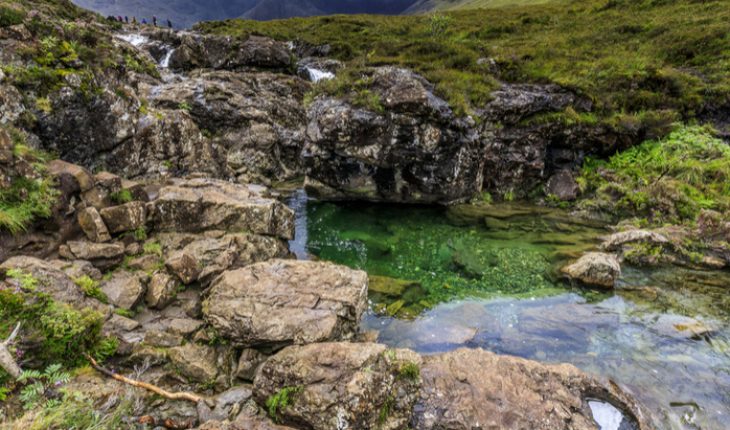Wild swimming – the simple art of swimming in natural water bodies outdoors – is making a comeback, with more people using our rivers and lakes for swimming than canoeing and fishing combined. The desire for wild swimming also reflects increased interests in ‘wild’ experiences – activities that immerse you in visceral beauty, wash away stresses of the day job and provide a real adventure in our overly cosseted ‘health and safety’ worlds.
Britain is blessed with a fantastic range of locations for swimming. Cornwall, Dorset and Pembrokeshire are famous for coves, sea caves and rock arches. When you arrive at an otherwise inaccessible white sand beach, and wade up out of the simmering ocean, you feel like Robinsoe Crusoe washed ashore.
When you arrive at an otherwise inaccessible white sand beach, and wade up out of the simmering ocean, you feel like Robinsoe Crusoe washed ashore.
If you are lucky you will see seals or dolphins too. There are many freshwater venues too, from the tarns of Wales, waterfalls pools of the Lakes and wooded lakes of Sussex. Why not leap off a 20 jump into a deep plunge pool, swim down a series of chutes on the river Dart or go skinny dipping under a full moon on a summer night. This is the kind of wild sport that is exciting, good for you and completely free.
The health and psychological benefits of dipping in natural waters have long been known, as our many spa towns are testament to. Florence Nightingale and Charles Dickens both claimed to have been cured by these traditional forms of ‘hydrotherapy’. First, a one-off dunk creates intense vasodilation, pumping out muscle lactates, and bringing fresh blood to the extremities.
First, a one-off dunk creates intense vasodilation, pumping out muscle lactates, and bringing fresh blood to the extremities.
The Turks and Romans understood this with their hot-cold plunge pools, and so does Paula Radcliffe, who always takes a cold shower before a race. Second, a cold dip also provides a psychological kick start too. A powerful endorphin shot is released and this natural high bringing on intense feelings of well -being and an addictive urge to dive back in. Third, after regular swimming, a process known as cold adaptation kicks in. Not only does this reduce your body’s sensation of coldness (making even the coldest water quite pleasant), it is clinically proven to boost mode, libido and the immune system – as shown in NASA experiments from the 1980s.
All wild-dippers know the natural endorphin high that raises mood, elates the senses and creates an addictive urge to dive back in. However the world seemed before a swim, it looks fantastic afterwards.
The long-term impacts are also well researched: NASA studies have shown that, over a 12-week period, repeated cold swimming leads to substantial bodily changes known as ‘cold adaptation’. These bring down blood pressure and cholesterol, reduce fat disposition, inhibit blood clotting and increase fertility and libido in both men and women. Far from quelling passion, a cold shower will boost vitality and desire.
Coldwater swimming is also a sure-fire way to burn calories quickly and building muscle tone and graceful technique. If you want to get started you need very little beyond some trunks (remember plastic bag to take them home in), a small travel towel (or sarong), and ideally some lightweight aqua shoes. Plan a walk or run so you arrive hot and sweaty, and you should be able to manage 20 minutes without a wetsuit. For a longer session, or if you are heading into unknown territory – particularly the sea – you will need wetsuit. A simple swim cap will also conserve a huge amount of heat, and add to your visibility.
To stay safe, never swim alone and remember, if this is your first time, stay or swim close to the shore – cold water will dramatically decrease your range at first, and for some people can bring on breathing difficulties in the first few minutes, so practise in a safe zone and increase your range slowly. In rivers, keep an eye on downstream, and always plan your emergency exit. In the sea, don’t swim from headlands unless you understand tidal currents, and don’t swim in high surf conditions, unless you understand rip currents.
In the sea, don’t swim from headlands unless you understand tidal currents, and don’t swim in high surf conditions, unless you understand rip currents.
When you get out, it can take longer than you think to warm up, so have plenty of clothing ready, or head straight off on another walk or run. Wild swimming is a superb way to break down barriers and build an instant sense of comradeship. You will be feeling fantastic when you get out, and keen to go back in, so plan your route to take in a few more dips too! Your first time wild swimming is guaranteed to be one of the most memorable days this summer.
Wild Swimming by Daniel Start (£16.99, Wild Things Publishing) wildswimming.co.uk
- Wild swimming this summer: hazards to avoid - 26th July 2018
- Wild swimming washes away stress - 7th August 2017







